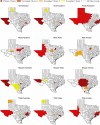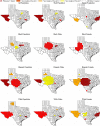Detecting spatiotemporal clusters of accidental poisoning mortality among Texas counties, U.S., 1980 - 2001
- PMID: 15509301
- PMCID: PMC529305
- DOI: 10.1186/1476-072X-3-25
Detecting spatiotemporal clusters of accidental poisoning mortality among Texas counties, U.S., 1980 - 2001
Abstract
BACKGROUND: Accidental poisoning is one of the leading causes of injury in the United States, second only to motor vehicle accidents. According to the Centers for Disease Control and Prevention, the rates of accidental poisoning mortality have been increasing in the past fourteen years nationally. In Texas, mortality rates from accidental poisoning have mirrored national trends, increasing linearly from 1981 to 2001. The purpose of this study was to determine if there are spatiotemporal clusters of accidental poisoning mortality among Texas counties, and if so, whether there are variations in clustering and risk according to gender and race/ethnicity. The Spatial Scan Statistic in combination with GIS software was used to identify potential clusters between 1980 and 2001 among Texas counties, and Poisson regression was used to evaluate risk differences. RESULTS: Several significant (p < 0.05) accidental poisoning mortality clusters were identified in different regions of Texas. The geographic and temporal persistence of clusters was found to vary by racial group, gender, and race/gender combinations, and most of the clusters persisted into the present decade. Poisson regression revealed significant differences in risk according to race and gender. The Black population was found to be at greatest risk of accidental poisoning mortality relative to other race/ethnic groups (Relative Risk (RR) = 1.25, 95% Confidence Interval (CI) = 1.24 - 1.27), and the male population was found to be at elevated risk (RR = 2.47, 95% CI = 2.45 - 2.50) when the female population was used as a reference. CONCLUSION: The findings of the present study provide evidence for the existence of accidental poisoning mortality clusters in Texas, demonstrate the persistence of these clusters into the present decade, and show the spatiotemporal variations in risk and clustering of accidental poisoning deaths by gender and race/ethnicity. By quantifying disparities in accidental poisoning mortality by place, time and person, this study demonstrates the utility of the spatial scan statistic combined with GIS and regression methods in identifying priority areas for public health planning and resource allocation.
Figures




References
-
- US National Center for Injury Prevention and Control, [http://www.cdc.gov/ncipc/default.htm] Accessed July 20, 2004.
-
- Centers for Disease Control and Prevention (CDC) Unintentional and undetermined poisoning deaths--11 states, 1990-2001. MMWR Morb Mortal Wkly Rep. 2004;53:233–238. Accessed July 20, 2004. - PubMed
-
- Sahin HA. Sahin I. Arabaci F. Sociodemographic factors in organophosphate poisonings: a prospective study. Human & Experimental Toxicology. 2003;22:349–353. - PubMed
LinkOut - more resources
Full Text Sources
Miscellaneous

